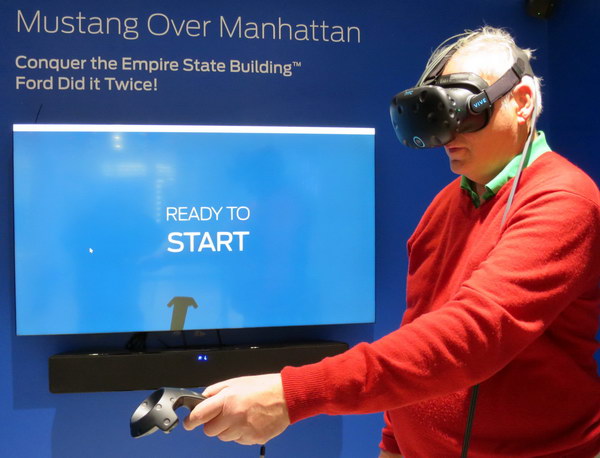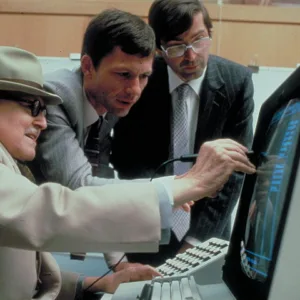To celebrate the 50th anniversary of the Mustang, Ford did a VR recreation of a stunt they first performed 50 years ago and repeated as part of the 50th anniversary celebration: they put a Mustang on the top of the Empire State Building in New York. This is not as easy as it sounds because they had to cut the Mustang into parts to fit into the 32” (81cm) wide elevator door. The building is far too tall for the car to be hoisted up by a crane and presumably they could not get permission to use a helicopter in densely-packed Manhattan. Besides, they didn’t use a helicopter 50 years ago so they didn’t want to use one now.
 Meko’s Matt Brennesholtz starts Ford’s “Mustang over Manhattan” VR experience by grabbing a virtual Mustang logo with a HTC Vive controller. (Photo: M. Brennesholtz)
Meko’s Matt Brennesholtz starts Ford’s “Mustang over Manhattan” VR experience by grabbing a virtual Mustang logo with a HTC Vive controller. (Photo: M. Brennesholtz)
The Ford VR experience involved first reassembling the virtual Mustang on top of the virtual Empire State building and then seeing the view from the observation deck in all directions – the spire of the Empire State and the Mustang behind you, the streets of Manhattan below you, clouds above you, New York Harbor and the rivers surrounding Manhattan island in the middle distance and New Jersey and Long Island fading into the horizon. There was no virtual railing or fence around the observation deck to block your view and they invited you to walk out onto a virtual platform where you could look straight down. (I declined!) The VR experience used HTC Vive headsets and a Vive controller. The controller operated the virtual elevator and allowed the user to pick up, manipulate and reassemble the virtual Mustang.
The VR experience was created using Dassault Systèmes’ 3Dexperience platform. Dassault Systèmes was spun out of Dassault Aviation in 1981 as a 3D CAD company and introduced its first product, Catia, the same year. By 1984, Catia became the world’s leading application for aeronautical design. The current 3D CAD version of Catia is still heavily used by both the aviation and automotive industries, presumably including Ford, as well as other industries.
3D CAD design with Catia in 1981. (Image: Dassault Systèmes)
The 3D abilities of Dassault Systèmes have grown over the years and they have introduced the 3DExperience platform specifically for the production of corporate VR experiences, such as Ford’s “Mustang over Manhattan.” According to Dassault Systèmes, the platform “provides software solutions for every organization in your company – from marketing to sales to engineering – that help you, in your value creation process, to create differentiating consumer experiences. With a single, easy-to-use interface, it powers industry solution experiences, based on 3D design, analysis, simulation and intelligence software in a collaborative interactive environment. It is available on premise and in public or private cloud.”
There you have it. If you want to design an automobile, you can use Catia. If you want to place that car into a Virtual World for design, marketing or sales reasons, you can use the 3DExperience platform. The 3D design data from Catia can be transferred seamlessly into 3DExperience so you don’t have to redesign the car or airplane to place it in a fully interactive, 3D virtual world. My only complaint is the HTC Vive and every other VR HMD I’ve ever tested simply doesn’t have enough resolution to do justice to the VR experiences that can be created by modern VR production technologies such as the 3DExperience platform. –Matthew Brennesholtz

